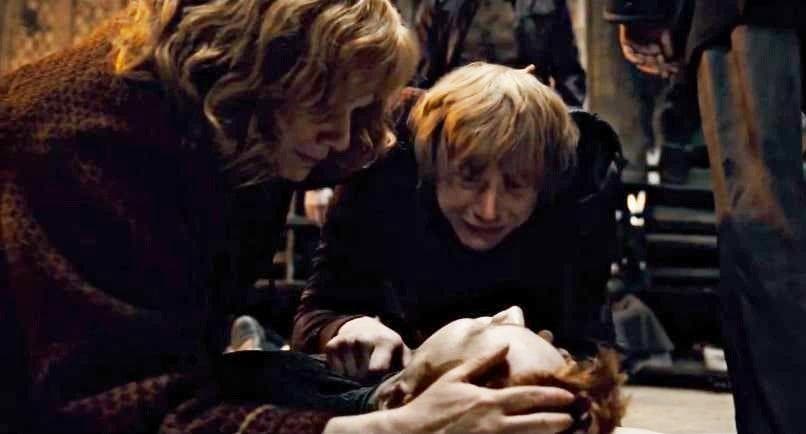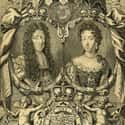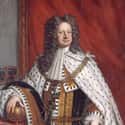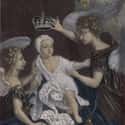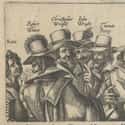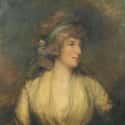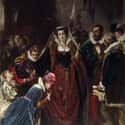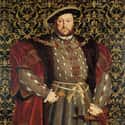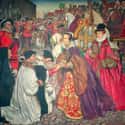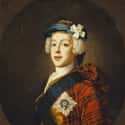-
(#1) The English Would Rather Have A Revolution Than A Catholic King
James II was a Catholic king - and English Protestants were totally not okay with it. Even though he was Catholic, his two daughters - Mary and Anne - were Protestant, and many English men and women were simply biding their time until the king died and one of the Protestant princesses would ascend the throne. In 1688, those dreams were dashed when James and his Catholic wife had a male heir. Since boys always inherited ahead of girls at this time, it meant that James II would be succeeded by a Catholic prince.
Parliament wouldn't stand for it. Rather than accept a Catholic monarch, they invited Princess Mary and her Dutch husband William of Orange to come to England and rule instead of her father. Panicked, James, Mary, and their baby boy fled for the continent. The Glorious Revolution of 1688 basically confirmed that Catholic kings were not welcome in England.
-
(#2) More Than 50 Catholics Were Skipped Over To Make Sure A Protestant Inherited The Throne - Even Though He Didn't Speak English
When Protestant Queen Anne's only living child died tragically in 1700 at the age of 11 - sadly, though she had 17 pregnancies, none of Anne's children survived to adulthood - the English and Scottish thrones had no direct heir. The crown faced a succession crisis and the possibility of a Catholic inheriting the throne reared its head once more.
So in 1701, Parliament passed the Act of Settlement, which settled the question of succession. It decreed that only Protestants could ascend the throne. Moreover, Protestant kings and queens couldn't even have a Catholic spouse.
Parliament struggled to find a legitimate heir to fit the bill, and it finally settled on one of Anne's distant relatives, George of Hanover. By electing to make George the heir, it skipped over more than 50 Catholics who had a better claim to the throne than a prince of a Germanic state. How did George become the heir? He was the great-grandson of James I, and so he succeeded Queen Anne in 1714. He may have been a German who didn't even speak English - but at least he wasn't a Catholic.
-
(#3) Charles II Converted To Catholicism On His Deathbed Because Anti-Catholic Sentiment Prevented Him From Getting Around To It Sooner
When Charles II became king in 1660, he took the reins of an England that had become severely anti-Catholic. Catholics were even blamed for starting the Great Fire of London in 1666. Seven years later, Parliament passed the Test Act, which basically tested military and government officials by requiring them to take a Protestant oath. Parliament even tried to strong-arm Charles into excluding his younger brother James from the throne. James was an avowed Catholic, and, since Charles didn't have an heir of his own, the crown would pass to him. Charles refused, and his brother remained his heir.
Despite fears of "Popish Plots" that pervaded England and Scotland, Charles actually had a sneaking admiration for Catholicism. In fact, he was resolved to become a Catholic himself. But, correctly gauging the anti-Catholicism of his subjects, he waited until the last possible moment. He converted on his deathbed in 1685.
-
(#4) Autumn Kelly Was Raised A Catholic And Had To Convert Before She Could Marry Prince Harry's Cousin In 2008
Prince Harry isn't the first member of the royal family to wed a North American bride. In 2008, Harry's cousin Peter Phillips - Queen Elizabeth I's eldest grandchild - married Autumn Kelly, a McGill-educated Canadian. Kelly actually grew up as a Catholic, and even attended Catholic school. While this fact did not prevent the marriage from taking place, the Act of Settlement did mean that Peter Phillips's place in the line of succession was threatened by marrying a Catholic. Per the 1701 law, men and women in the line of succession could lose their place if they married a Catholic. So shortly before her May 2008 wedding, Kelly actually renounced her Catholic faith and converted to Anglicanism.
If Phillips and Kelly had waited only a few more years, she would not have had to go through the trouble of converting. In 2013, the monarchy modernized a bit thanks to the Succession to the Crown Act. Among other things, the act states that men and women in the royal family can marry Catholics and retain their place in the line of succession.
-
(#5) The Warming-Pan Scandal Was A Moment When Protestants Freaked Out Over The Birth Of A Catholic Heir
When James II became king in 1685, he was the first Catholic to ascend the throne in over a century - and it freaked everyone out. Protestants distrusted James so much that they feared he had a Catholic agenda. But they accepted him at first, since his two daughters and likely heirs were firm Protestants. Mary and her younger sister Anne had no intention of converting to Catholicism, and so Protestants tolerated James because they knew that things would go back to normal when one of his daughters became queen.
But that all changed in 1688 when James and his young, Catholic wife welcomed a legitimate male heir whose gender threatened to downgrade his Protestant older sisters in the line of succession. If Protestants were concerned before, they were losing it now. Rumors started to circulate that the infant - James Francis Edward Stuart, the Prince of Wales - wasn't the legitimate son of James at all. The real infant prince was stillborn, many insisted, and the baby that now slumbered in royal cradle had been born to someone else and smuggled into the palace in a warming pan. The scandal was noisy enough that it threatened to make illegitimate the king's bouncing baby boy.
-
(#6) Remember, Remember That The Fifth Of November Was About The Persecution Of English Catholics
After England became a Protestant kingdom in the 1530s - with a brief return to Catholicism under Mary I between 1553 and 1558 - Catholics were marginalized. Their ties to the Catholic Church and a foreign figure of authority - the Pope in Rome - were met with suspicion by a crown that defined its authority by being head of its own Protestant Church. Elizabeth I proved herself to be Queen of Anti-Catholicism in England, as she persecuted Catholics through penal laws that fined them and marked priests as treasonous traitors. Many priests were even executed.
Her successor James I was the son of Catholics - Queen Mary of Scotland was his mother - but he remained committed to Protestantism in England. It would be an understatement to say that English Catholics were not thrilled about the same, old forms of persecution under a new king. So on November 5, 1605, a group of them took matters into their own hands by engineering the so-called Gunpowder Plot: they intended to blow up parliament, thereby assassinating James I. They then planned to kidnap his young daughter, Princess Elizabeth. They intended to raise Elizabeth as a Catholic and name her queen. The conspirators didn't get very far, and the plot was uncovered before they could even light a fuse.
Though the plot failed, "Guy Fawkes Day" or "Bonfire Night" is still celebrated in England to commemorate the defeat of the Gunpowder Plotters.
-
(#7) The Future George IV Knew He Couldn't Legally Marry A Catholic, So He Married One Illegally
Thanks to the Act of Settlement - which stated that men and women in the line of succession couldn't have a Catholic spouse - the future George IV knew that he would have to take a Protestant as his bride. So when he fell head over heels for Maria Fitzherbert, a twice-widowed Catholic, he knew there was no chance they could get married. Moreover, the Royal Marriages Act of 1772 insisted that a member of the royal family had to seek permission from the monarch to get married. Again, George soberly faced the truth: there was no way that his stodgy, old father was going to let his eldest son and heir marry a Catholic widow.
So George took matters into his own hands. On December 15, 1785, he secretly married Maria Fitzherbert in an illegal ceremony. Though the marriage had a romantic start, it had fizzled out in less than a decade. In 1794, George broke it off with Fitzherbert for the most unromantic reason: his father agreed to settled his debts, if only he'd take a legal bride.
In April 1795, George married his Protestant bride, the German Princess Caroline of Brunswick. It was basically hate at first sight, and the marriage proved to be an epic disaster.
-
(#8) Elizabeth I Executed A Foreign Queen Because Some English Subjects Wanted Her To Become Their Catholic Ruler
Elizabeth I was a Protestant queen of a Protestant England. Her neighbor to the north was Queen Mary of Scotland - and Mary had the discomfort of being a Catholic queen of an increasingly Protestant kingdom. In 1567, Mary was forced to abdicate in favor of her one-year-old son James, who would be raised as a Protestant. She fled to England, hoping that her cousin Elizabeth would protect her.
Instead, Elizabeth imprisoned Mary for nearly two decades. During that time, schemers hatched several plots to depose Elizabeth and install Mary as a Catholic queen in England. The Babington Plot was the last straw. Elizabeth finally agreed to eliminate the threat Mary and her religion posed to her authority by executing her Scottish cousin on February 8, 1587.
-
(#9) Henry VIII Divorced England From The Catholic Church Because He Had The Hots For A Woman Who Wasn't His Wife
Romance, religion, and politics never blended together so spectacularly than in the case of Henry VIII. In fact, the English monarchy's tension with Catholicism can be traced directly back to him, a king with large appetites and an even larger ego. When Henry ascended the throne in 1509 at the age of 18, England was firmly a Catholic kingdom. So Catholic was England that Pope Leo X actually named Henry "Defender of the Faith" in 1521 after the English king wrote a diatribe against Protestant rabble-rouser Martin Luther, architect of the so-called Protestant Reformation.
But that soon changed. After over two decades of marriage, Henry and his wife Catherine of Aragon still did not have a male heir. So Henry's attentions turned to Anne Boleyn, a lady in the court who promised him a son. Henry used all his power and influence to try and pressure the pope into granting him an annulment from Catherine - but the pope wouldn't budge. Instead, Henry divorced England from the Catholic Church and in 1534 decreed that he was the head of a new Protestant Church of England. Henry's English Reformation was brutal and bloody, and it was a significant moment in the history of the monarchy when the king gave himself the authority to command the souls of men and women. Catholicism was out, and Protestantism was in.
Since he now headed of the Church of England, Henry had no trouble disposing one wife and taking on another. Henry and Anne married in January 1533. They welcomed a daughter - not the promised son - later that year.
-
(#10) The Act Of Settlement Ruined A Perfectly Good Love Story Between Queen Victoria's Grandson And A French Princess
Passed in 1701, the Act of Settlement got all up in royals' love lives. It decreed that any British royal who married a Catholic would have to forfeit his or her place in the line of succession. This meant that British royals married into Protestant royal families across Europe. But it also meant that affection was sometimes thwarted.
In 1890, Queen Victoria's grandson and second-in-line to the throne Prince Albert Victor fell in love with Princesse Hélène d'Orléans. The catch? She was a French Catholic. Though Queen Victoria genuinely sympathized with the couple, her hands were tied by the Act of Settlement, Parliament's unwillingness to accommodate their love, and the Pope's refusal to grant a dispensation. Heartbroken, the star-crossed lovers parted ways, and Prince Albert died unmarried two years later.
-
(#11) Mary I Was A Catholic Who Got A Bad Rep As "Bloody Mary" Because Protestants Really Didn't Like Her
Though her father instituted the English Reformation in the 1530s, Queen Mary I had no intention of renouncing her Catholic faith when she unexpectedly ascended the throne in 1553 at the age of 37. Though she was pragmatic and understood that her subjects were both Catholic and Protestant, she also felt that it was her unique duty to restore Catholicism to England. Her choice of a Spanish Catholic husband alienated her from her subjects, especially Protestant ones.
Was Mary really "bloody"? Well, Mary did execute hundreds of Protestants - but her sister Elizabeth likewise executed Catholics. The root of the "Bloody Mary" myth actually comes from Protestant propaganda that unfairly painted the Catholic queen as a bloodthirsty tyrant.
-
(#12) Jacobite Pretenders Were Catholic Claimants Who Put Up A Fight For Over 50 Years
In 1688, the English Parliament ousted the Catholic King James II in favor of his Protestant daughter Mary II and her Dutch husband William of Orange. Besides giving their name to the College of William and Mary in Virginia, the royal couple also secured the future of a Protestant, rather than a Catholic, monarchy.
But James and his descendants never gave up fighting for what they believed was their birthright. "Jacobites" - followers of James's Catholic line of descent - in both England and Scotland were enlisted in the secret cause to restore James and his descendants to the throne. Though some Jacobites were not Catholic, James's Catholicism was nonetheless a rallying point for many supporters.
When James died in 1701, Jacobites pledged themselves to helping his son James Francis Edward - nicknamed the "Old Pretender" - take the crown. Jacobites also threw their support behind James Francis Edward's son, Charles Edward Stuart, the "Young Pretender." More than simply toasting their "king across the water," Jacobites pledged their lives to the cause. After all, treason was no small offense.
After several bloody uprisings, Jacobitism was defeated for once and for all at the Battle of Culloden in 1746.
New Random Displays Display All By Ranking
About This Tool
In October of that year, the media began to report Prince Harry's love affair. Everyone thought it was just a new relationship with Prince Harry. No one did expect that they would eventually get married. Megan’s identity is very complicated. She is a Protestant, but she went to a girls’ school run by the Catholic Church since she was a child. According to the canons of the Anglican Church and the "Royal Marriage Act" enacted in 1772, the spouses of members of the royal family must be members of the Anglican Church.
However, the law was changed in 2015, which allowing an important member of the royal family to marry a Catholic. The purpose is to eliminate male prejudice and religious discrimination in the royal order. The random tool explained 12 historical details about the marriage of Prince Harry and Megan.
Our data comes from Ranker, If you want to participate in the ranking of items displayed on this page, please click here.






